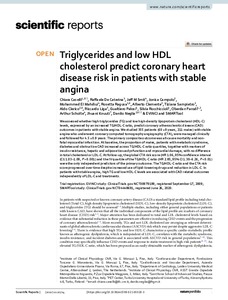Triglycerides and low HDL cholesterol predict coronary heart disease risk in patients with stable angina
Campolo Jonica; Clemente Alberto; Sampietro Tiziana; Scholte Arthur; Liga Riccardo; Rocchiccioli Silvia; Smit Jeff M.; Neglia Danilo; EVINCI; SMARTool; Ragusa Rosetta; Clerico Aldo; Parodi Oberdan; Pelosi Gualtiero; Caselli Chiara; Knuuti Juhani; De Caterina Raffaele; El Mahdiui Mohammed
https://urn.fi/URN:NBN:fi-fe2022012710765
Tiivistelmä
We assessed whether high triglycerides (TG) and low high-density lipoprotein cholesterol (HDL-C) levels, expressed by an increased TG/HDL-C ratio, predict coronary atherosclerotic disease (CAD) outcomes in patients with stable angina. We studied 355 patients (60 ± 9 years, 211 males) with stable angina who underwent coronary computed tomography angiography (CTA), were managed clinically and followed for 4.5 ± 0.9 years. The primary composite outcome was all-cause mortality and non-fatal myocardial infarction. At baseline, the proportion of males, patients with metabolic syndrome, diabetes and obstructive CAD increased across TG/HDL-C ratio quartiles, together with markers of insulin resistance, hepatic and adipose tissue dysfunction and myocardial damage, with no difference in total cholesterol or LDL-C. At follow-up, the global CTA risk score (HR 1.06, 95% confidence interval (CI) 1.03-1.09, P = 0.001) and the IV quartile of the TG/HDL-C ratio (HR 2.85, 95% CI 1.30-6.26, P < 0.01) were the only independent predictors of the primary outcome. The TG/HDL-C ratio and the CTA risk score progressed over time despite increased use of lipid-lowering drugs and reduction in LDL-C. In patients with stable angina, high TG and low HDL-C levels are associated with CAD related outcomes independently of LDL-C and treatments.
Kokoelmat
- Rinnakkaistallenteet [16063]
